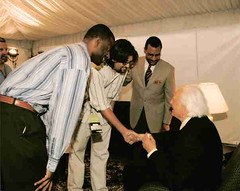Behind the curve, again
 Five years ago, a global evangelical ministry asked a group of youth workers how to become relevant to young people. We suggested leveraging the power of the internet to create a "virtual youth center" where kids could share interests and ideas, find their voice, and connect. Several months later they hired me to write a creative brief unpacking the idea. We called it "MyLife.com." The brief was scheduled to go before the ministry's Board in September 2001, but 9/11 derailed it. Subsequent management and program changes kept the idea shelved.
Fast forward five years, and the cover of Business Week heralds "The MySpace Generation" (12/12/05):
Five years ago, a global evangelical ministry asked a group of youth workers how to become relevant to young people. We suggested leveraging the power of the internet to create a "virtual youth center" where kids could share interests and ideas, find their voice, and connect. Several months later they hired me to write a creative brief unpacking the idea. We called it "MyLife.com." The brief was scheduled to go before the ministry's Board in September 2001, but 9/11 derailed it. Subsequent management and program changes kept the idea shelved.
Fast forward five years, and the cover of Business Week heralds "The MySpace Generation" (12/12/05):
"Preeminent among these virtual hangouts is MySpace.com, whose membership has nearly quadrupled since January alone, to 40 million members. Youngsters log on so obsessively that MySpace ranked No. 15 on the entire U.S. Internet in terms of page hits in October, according to Nielsen//NetRatings. Millions also hang out at other up-and-coming networks such as Facebook.com, which connects college students, and Xanga.com, an agglomeration of shared blogs. A second tier of some 300 smaller sites, such as Buzz-Oven, Classface.com, and Photobucket.com, operate under -- and often inside or next to -- the larger ones. "Although networks are still in their infancy, experts think they're already creating new forms of social behavior that blur the distinctions between online and real-world interactions. In fact, today's young generation largely ignores the difference. Most adults see the Web as a supplement to their daily lives. They tap into information, buy books or send flowers, exchange apartments, or link up with others who share passions for dogs, say, or opera. But for the most part, their social lives remain rooted in the traditional phone call and face-to-face interaction. "The MySpace generation, by contrast, lives comfortably in both worlds at once. Increasingly, America's middle- and upper-class youth use social networks as virtual community centers, a place to go and sit for a while (sometimes hours). While older folks come and go for a task, Adams and her social circle are just as likely to socialize online as off. This is partly a function of how much more comfortable young people are on the Web: Fully 87% of 12- to 17-year-olds use the Internet, vs. two-thirds of adults, according to the Pew Internet & American Life Project. "Teens also use many forms of media simultaneously. Fifteen- to eighteen-year-olds average nearly 6 1/2 hours a day watching TV, playing video games, and surfing the Net, according to a recent Kaiser Family Foundation survey. A quarter of that time, they're multitasking. The biggest increase: computer use for activities such as social networking, which has soared nearly threefold since 2000, to 1 hour and 22 minutes a day on average." Article.Is it petty and childish to say, "ARGH"? My MySpace account.













2 Comments:
jeremy ....thank you for publishing this article. it is startling in its implications.i have never seen anyone who has his finger on the pulse of this generation as you do. you are a tremendous prophetic voice and a voice that must be heard
Wow. Thanks for the compliments. If all that's true, then I probably need to avoid commentary like, "ARGH!"
Post a Comment
<< Home